
Lasius is a genus of formicine ants. The type species for this genus is the black garden ant, Lasius niger. Other major members, which live in drier heathland, are the cornfield ant, L. neoniger, and L. alienus. Other species include the temporary social parasites of the L. mixtus group and the hyper-social parasite Lasius fuliginosus. Lasius flavus is also a commonly seen species, building grassy hillocks in undisturbed pasture. In the Alps, these mounds - always aligned east to catch the first rays of the rising sun - have been traditionally used by goatherds as natural compasses.
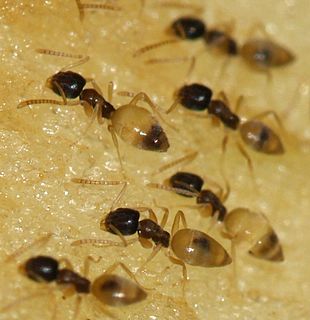
Tapinoma is a genus of ants that belongs to the subfamily Dolichoderinae. The genus currently comprises 74 described species distributed worldwide in tropical and temperate regions. Members of are generalized foragers, nesting in a wide variety of habitats, ranging from grasslands, open fields, woodlands, to inside buildings. The majority of species nest in the ground under objects such as stones or tree logs, other species build nests under bark of logs and stumps, in plant cavities, insect galls or refuse piles.

Trap-jaw ants are a genus (Odontomachus) of omnivorous ants found in the tropics and subtropics throughout the world.

Myrmoteras is a genus of ants in the subfamily Formicinae and the sole member of the tribe Myrmoteratini. They have enormous eyes, a character found in other ancient genera, and extremely elongated mandibles with eight to 16 teeth. These work as trap-jaws and can open up to 270°.

Leptanilla is a genus of ant in the subfamily Leptanillinae. Like other genera in this subfamily, the queen is fed by the hemolymph of their own larvae, which have specialized processes for this purpose.

Aenictus is a large army ant genus distributed in the Old World tropics and subtropics. It contains about 181 species, making it one of the larger ant genera of the world.

Anochetus is a genus of small, carnivorous ants found in the tropics and subtropics throughout the world.

Cryptopone is a genus of ants in the subfamily Ponerinae. The genus has a worldwide distribution, with most species occurring in Asia. Workers range from very small to medium in size (1.7–6.1 mm), with the queens being slightly larger.

Myopias is a genus of ants in the subfamily Ponerinae. The genus is known from the Oriental, Indo-Australian, and Australasian regions.

Cerapachys is a genus of ants in the subfamily Dorylinae. Species are mainly myrmecophagous ants which raid the nests of other ants for prey. The genus is distributed widely throughout the Indomalayan region. The genus was revised by BoroWiec (2016) who split a number of previously synonymized genera out of Cerapachys, leaving only 5 species in the genus.
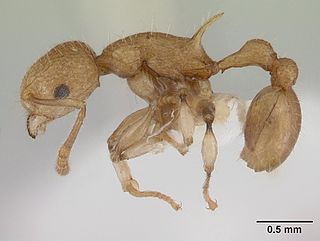
Vombisidris is a genus of subarboreal and arboreal ants in the subfamily Myrmicinae. Its species are known from India to Queensland, Australia. Like most other arboreal ants, their biology remains unknown.

Lordomyrma is a genus of ants in the subfamily Myrmicinae.

Vollenhovia is a genus of ants in the subfamily Myrmicinae.

Carebara is a genus of ants in the subfamily Myrmicinae. It is one of the largest myrmicine genera with more than 200 species distributed worldwide in the tropics and the Afrotropical region. Many of them are very tiny cryptic soil and leaf litter inhabitants. They nest in rotten wood to which the bark is still adherent in the Afrotropical region, or may be lestobiotic nesting near other ant species. Some species are known to exist parasitically within termite nests. Little is known about the biology of the species. However, they are notable for the vast difference in size between queens and workers.
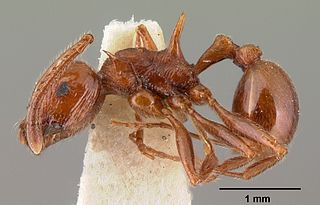
Pristomyrmex is a genus of ants in the subfamily Myrmicinae.
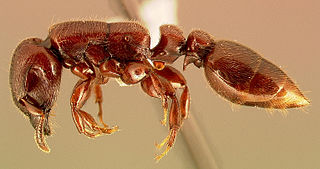
Metapone is an Old World genus of ants in the subfamily Myrmicinae. The genus is found in the Indo-Australian, Oriental and Malagasy regions. Most species are known only from a few specimens.

Lophomyrmex is a genus of ants in the subfamily Myrmicinae. It is known from the Oriental and Indo-Australian regions.

Pseudolasius is a genus of ants in the subfamily Formicinae. The genus is known from southern Asia to northern Australia, where it appears to be restricted to tropical areas.
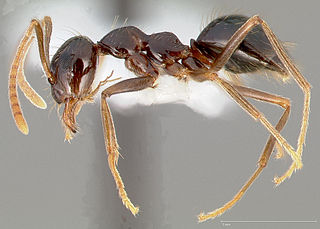
Prenolepis is a genus of ants in the subfamily Formicinae. Most species are found in southeastern Asia and southern China, but the genus has a wide distribution with species known from North America, southern Europe, Anatolia, Cuba, Haiti, and West Africa.

Lioponera is a genus of ants in the subfamily Dorylinae containing approximately 74 described species. The genus is distributed widely across the Afrotropical, Australasia, Indomalaya, Malagasy, and Palearctic bioregions. Lioponera was described by Mayr (1879) and later placed as a junior synonym of Cerapachys by Brown (1975). Lioponera was resurrected as a valid genus by Borowiec (2016) during redescription of the doryline genera.




















